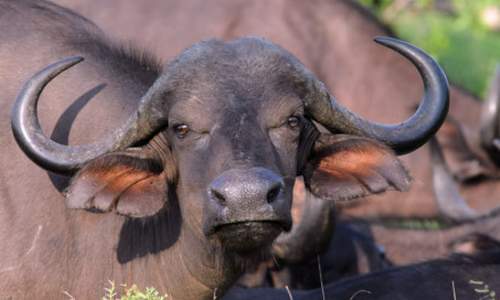
Her research has, however, revealed other aspects of how the disease progresses in buffalo, particularly with respect to their social structure. Buffalo seem to be what is known as a 'maintenance host' for bovine TB, living for a long time in reasonably good condition once infected with the disease.
While looking physically healthy, they can spread the disease to a lot of herd members and a variety of other animals, making the disease a long-term threat.
Vaccination Versus Other Control Measures

Treatment for bovine TB is totally impractical in free-ranging buffalo. To be successful, drugs need to be given frequently and for a long period of time, which would involve continually darting thousands of animals. Park management ruled out culling all animals that test positive for BTB, which is how the disease is treated in domestic cattle.
Before the disease was so widespread in Kruger, fencing diseased buffalo herds off from uninfected herds was also rejected as a control measure.
If a suitable vaccine could be found, buffalo calves in Kruger could get immunity to the disease through vaccination, and grow into healthy adults without catching the disease from other herd members.This would help control the spread of the disease, especially in herds where a low percentage of individuals are infected. As bovine TB is a problem in other wild animals around the world, Lin-Mari began her work on a TB vaccine in New Zealand. There, BTB is a problem in red deer.A vaccine similar to that used in humans, the BCG (Bacille-Calmette Guerin) vaccine, was found to be 95 percent effective against BTB in deer. Returning to Kruger, she first did research on how healthy buffalo can be infected experimentally with the bacterium that causes bovine TB.
Once that had been established, she could start testing the BCG vaccine. Using yearling buffalo calves that were caught in the north of the park, the first vaccine trials were carried out in bomas near Skukuza.Half the buffalo were vaccinated with the BCG vaccine, while the other half were untreated. They were all then exposed to a dose of the bacteria that Lin-Mari had previously established would cause BTB in healthy animals.
First Trials Show Some Positive Results


To try and simulate natural conditions more accurately, a second BCG vaccine study was carried out using buffalo yearlings that were allowed to be free-ranging in a 100ha enclosure after they had been caught in the wild and then vaccinated.This trial also looked at how readily the bacterium passed between the healthy yearlings and some adult cows that were taken from BTB infected herds in the south of the park. After a year of being in the same enclosure together, the yearlings had not caught the disease from the adults.
Social Interactions Affect The Spread Of BTB
Lin-Mari suspects this is because of how the buffalo formed social groups. The cows that were introduced to the yearlings never spent much time with them in the enclosure. They preferred to spend time with their own calves and other females that had calves or were pregnant, largely ignoring the yearlings. This meant that Lin-Mari had to give the yearlings a dose of Mycobacterium bovis, the bacterium that causes BTB, and then check for disease again.Although a few lab culture results are still outstanding, examination of the animals' lymph tissue shows that the vaccine was only able to prevent active BTB in half of the vaccinated animals. In the yearlings that were not vaccinated, two-thirds developed the characteristic BTB esions.Interestingly, there were clear differences between the sexes in the numbers of animals that developed active TB. In both the vaccinated and non-vaccinated animals, far more females than males developed lesions. This was most obvious in vaccinated buffalo, where three times as many females got active TB than males.
More Females Than Males Get BTB
This seeming difference in immunity can also be linked to buffalo behaviour. As the buffalo were under close scrutiny while in the enclosure, Lin-Mari was able to see that the adult females in the enclosure would assert their social dominance over the yearling females, putting them under social stress.As the study group had not included older males, the yearling males did not have to compete with adult bulls, and so had a more carefree social existence. This is reflected in their more robust immune system.This shows that stress can cause TB to progress faster in buffalo, a finding that links up with human studies. Natural physically stressful events like the onset of puberty and pregnancy and lactation also have an effect on the immune system, and so implications for the progression of TB. This also ties in with New Zealand studies on red deer, where lactating mother deer showed faster disease progress than other female deer.
Vaccine Failures Linked To Foot And Mouth
When discussing why the BCG vaccine did not work against BTB in buffalo, Lin-Mari suggests that another disease may have a large role to play. Buffalo are carriers of foot and mouth disease (FMD), which is caused by a virus. Foot and mouth is widespread in Kruger, and buffalo are silent carriers of the disease. However, when a buffalo is first exposed to the FMD virus, its immune system still has to fight the virus.It seems that in the yearling buffalo, the young animal's immune system is so busy creating immunity to foot and mouth that it fails to produce the correct response to the BCG vaccine. The vaccine normally creates immunity by causing a change in how the animal's cells respond to the TB bacteria, making them able to destroy real TB bacteria if they are ever exposed to it.In the yearling buffalo, it seems that this process is interfered with by the immune reaction to FMD, because there are some major differences between immunity against viral versus bacterial infections.
Hope For The Future
Lin-Mari is hoping to find further funding to explore the use of the vaccine in calves younger than six months. These calves are still drinking their mother's milk, and through this get some maternal immunity to foot and mouth. If the BCG vaccine were used in this window period, it might allow the calves to develop complete resistance to BTB.One problem with using the vaccine on such young animals is that they would require two vaccinations, spaced six weeks apart. This is impractical for use in the field, so a vaccine that would only need a single jab would be better.

 African Buffalo or Cape Buffalo (Syncerus caffer). A large and powerful bovine, the African Buffalo reaches shoulder heights of up to 1.5 m ...
African Buffalo or Cape Buffalo (Syncerus caffer). A large and powerful bovine, the African Buffalo reaches shoulder heights of up to 1.5 m ... Answers to the most frequently asked questions about the African Buffalo which can be found in Kruger National Park...
Answers to the most frequently asked questions about the African Buffalo which can be found in Kruger National Park...